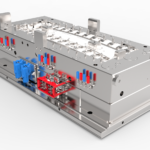Industrial plastics come in a great variety, each group of materials has its own purpose. From corrosion-resistant and engineering plastics to fluoropolymer and glazing materials – it won’t be an exaggeration to say that the offering has never been more diverse, catering to the needs of a broad range of industries. However, one group of industrial plastics – high-performance – thermoplastic- stands out from the crowd thanks to its wide spectrum of applications and exceptional properties.
Vespel is arguably the most known and frequently used brand of all of the high-performance plastics and for good reason – its extraordinary characteristics make this industrial plastic suitable for the toughest applications. So, what is the secret to such huge popularity? Well, there is more to it than just one trait or specificity, so read on to understand completely the purpose of a Vespel.
What Is Vespel Exactly?
To start with, Vespel is actually the trademark of DuPont, an American chemical giant whose motto is The miracles of science. A state-of-the-art product, Vespel is definitely one of such miracles, given that it can withstand both extremely high and low temperatures and remain stable in the harshest and most hazardous environments.
The best and most precise way to define Vespel is to say that it is a high-performance polyamide resin that is distinguished by a once-of-its-kind molecular structure. The latter comes in the shape of a ring and contains nitrogen. Vespel is a ground-breaking industrial plastic that uniquely combines important and widely used properties of many other materials, including ceramics and metals. This winning combination provides for the widest range of applications, making it the best choice for jet engines, heavy-duty off-road equipment, and semiconductors, to name just a few.
A perfect lightweight alternative to heavy metals, it is a great fit for all sizzling hot environments where the majority of thermoplastics quickly lose their essential mechanical properties. This is the main reason why Vespel is irreplaceable in aerospace technology, but, of course, it is also widely used on earth.
Most Common Types of Vespel
As already said, Vespel is a brand name that embraces various types of high-performance industrial plastic used in manufacturing. First off, there are two families of Vespel: Super Polymers (SP) and Super Coiled Polymers (SCP). The latter consists of products, which are stronger and stiffer in comparison to the former, offering far superior thermal stability in the long run. However, unless you are building a spacecraft or a super jet, you are unlikely to be in need of the SP grades.
Different grades vary by composition and, naturally, serve different purposes. One of the most widely used grades is vespel sp211 known for its extraordinary low-friction properties without lubrication. Plus, it offers incredible wear resistance up to 300˚F (149˚C), which is of utmost importance for a great many applications., including sliding or linear bearings. In contrast to other Super Polymers of this brand, it comprises 10% Teflon (PTFE), which explains its superior low friction performances.
Other most frequently used grades are:
- SP-21 – this one has a 15% of graphite by weight added to the base resin (S-1), providing for better wear resistance and decreased friction across various applications. It is highly suitable for bearings, bushings, seal rings, as well as other wear surfaces thanks to its excellent mechanical properties.
- SP-22 – for this particular grade, 40% graphite by weight is added to bolster wear resistance and get enhanced friction combined with a decent dimensional and oxidative stability. Even though typical applications of this grade do not differ from those of SP-21, it is worth mentioning that its coefficient of thermal expansion is the lowest of all the graphite-filled grades.
- SP-3 – a molybdenum disulfide-filled grade, this type is designed for top-notch friction and wear performance in vacuum or dry environments. No wonder, it was widely used during the early stages of space exploration. In addition to its outstanding behavior in a vacuum, this grade demonstrates excellent flammability characteristics, low outgassing, and great dimensional stability.
- SP-202 – the perfect fit for contactor pads, rollers, guides, and lift pin components, this grade lets users take advantage of its electrostatic charge removal, strong resistance to extremely high temperatures, and low wear rates.
Main Advantages Of Vespel
Vespel comes with a plethora of advantages, offering nearly endless opportunities for many different industries. The key to success is to learn the specificities and characteristics of various grades to make the right choice and figure out the best possible option for every individual project. Here are some main benefits of Vespel that made this industrial plastic a real hot ticket material:
- Incredible dimensional stability and continuous use up to 550ºF and intermittently up to 900° F
- It doesn’t get brittle even at such low temperatures as -400° F
- Ability to operate at very high pressure-velocity of 29 -3.5 MPa-m/s
- Low outgassing
- Resistance to chemical agents (fuels, hydraulic fluids, solvents, and others)
- Lack of metal content or any shedding in plasma provides for a very high level of purity
- Superior electrical insulation due to minimal thermal conductivity
- Excellent mechanical strength to cope with repeated handling or harsh cleaning cycles
- Really easily machined to hold close tolerances
- Flame retardant
- Resistance to radiation
- Resistance to hydrolysis and creep
What Is Vespel Used For?
As already mentioned, Vespel is in high demand across various industries, however, it is most commonly found in heavy-duty off-road equipment, jet engines, military equipment, and, of course, semiconductors and different types of vehicles. Needless to say, it is one of the most commonly used materials when it comes to aerospace applications and experts claim that almost every single jet engine produced in the West is enhanced with Vespel parts. The list of most commonly seen of them would include bearings, bushings, gaskets, insulators, piston and seal rings, thrust washers, wafer clamping, poppets, balls, and valve disks.
Even though Vespel is far from being the easiest material to work with, its extraordinary properties make it unrivaled in many segments. Not only aerospace but also gas and oil or automotive industries couldn’t develop so fast without Vespel, which continues to inspire new ideas and set new goals.













